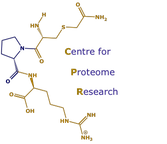MUPs can take up ligands from the environment
Robertson, D., Hurst, J.L., Hubbard, S.J., Gaskell, S.J. & Beynon, R.J. (1998) Ligands of urinary lipocalins from the mouse -uptake of environmentally-derived chemicals. J. Chem. Ecol. 24, 1127-1140 [PUBMED] [PDF]
Mouse urine contains large quantities of proteins (major urinary proteins, MUPs) that are thought to function by binding lipophilic and volatile semiochemicals in a central calyx of the MUP. Two notable semiochemicals are 2-sec-butyl-4,5-dihydrothiazole and a brevicomin (3,4-dehydro-exo-brevicomin). MUPs derived from deposits of urine from wild caught mice contain neither of these ligands, but are replete with menadione. The menadione is probably incorporated in vitro from the environment, although some incorporation in vivo can also be demonstrated. These data show that the calyx of MUPs can bind other hydrophobic molecules derived from the environment, which may influence longevity of signal and deposition patterns of urinary scent marks. The ability to displace, rapidly and completely, the natural ligands by menadione also provides a new tool in the analysis of MUP function.
Mouse urine contains large quantities of proteins (major urinary proteins, MUPs) that are thought to function by binding lipophilic and volatile semiochemicals in a central calyx of the MUP. Two notable semiochemicals are 2-sec-butyl-4,5-dihydrothiazole and a brevicomin (3,4-dehydro-exo-brevicomin). MUPs derived from deposits of urine from wild caught mice contain neither of these ligands, but are replete with menadione. The menadione is probably incorporated in vitro from the environment, although some incorporation in vivo can also be demonstrated. These data show that the calyx of MUPs can bind other hydrophobic molecules derived from the environment, which may influence longevity of signal and deposition patterns of urinary scent marks. The ability to displace, rapidly and completely, the natural ligands by menadione also provides a new tool in the analysis of MUP function.
